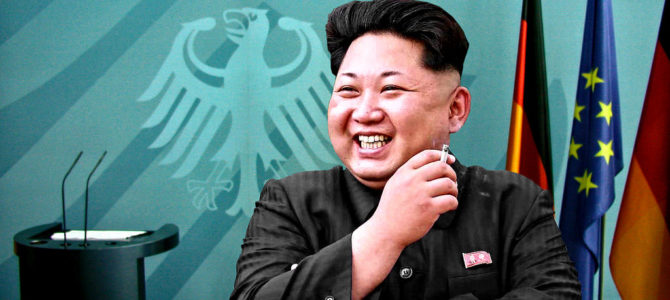
President Trump declared on Monday that the United States has re-designated North Korea as one of the “State Sponsors of Terrorism.” In his own words, President Trump called this “something that should have happened a long time ago.” He is right.
How North Korea Got On and Off the List
The United States will put countries that repeatedly support acts of international terrorism on the list of “state sponsors of terrorism (SST),” pursuant to three U.S. laws: section 6(j) of the Export Administration Act, section 40 of the Arms Export Control Act, and section 620A of the Foreign Assistance Act. There are serious, more than symbolic, implications for any country put on the list, including:
- A ban on arms-related sales and exports.
- Requiring 30-day congressional notification of exports of dual-use goods.
- The United States will oppose loans from international agencies such as the World Bank to designated country.
- Limiting diplomatic immunity to allow families of terrorist victims to file civil lawsuits in the United States.
- Prohibiting any U.S. person from engaging in financial transactions with the government of designated SST country.
Prior to Trump’s announcement, there were three countries on the SST list: Iran, Sudan, and Syria. North Korea was first put on this notorious list in 1987, after its agents planted a bomb on South Korean Airlines Flight 858 and killed all 115 on board on November 29th, 1987.
North Korea has also been known to persistently abduct South Korean and Japanese citizens for decades, especially during the 1970s and ’80s. In 2002, North Korean dictator Kim Jong Il openly acknowledged that his country kidnapped 13 Japanese citizens. Tokyo believes that as many as 800 missing Japanese could have been abducted by Pyongyang over the years.
Japan and South Korea are not the only two countries affected by North Korea’s orchestrated kidnappings. A 2014 United Nations report on human rights estimates that North Korea has kidnapped as many as 100,000 people from other countries through decades.
In 2008, during George W. Bush’s final year as president, his administration removed North Korea from the “State Sponsors of Terrorism” list to entice North Korea to return to nuclear weapon negotiations. As they say, the rest is history. North Korea used these negotiations to extract food and fuels from South Korea and the West, while secretly continuing to develop its nuclear weapons.
What Has Happened Since 2008
Removing North Korea from the SST list in 2008 failed to achieve its objective. The negotiations never bore much fruit. Instead, they provided North Korea with time and resources to continue accelerating its nuclear weapon development programs. Since 2008, North Korea has conducted five successful nuclear tests: 2009, 2013, in January and September 2016, and August 2017. Technically, North Korea is already a nuclear power.
Pyongyang has also made progress toward making a nuclear warhead small enough to attach an ICBM (Intercontinental Ballistic Missile), with the goal of reaching the United States. There is also evidence that Pyongyang is working with other “State Sponsors of Terrorism” such as Iran in illegal weapon trades and nuclear weapon development. Thus, Pyongyang’s nuclear weapon program has presented a grave security threat not only to people in the United States and South Korea and Japan, but also to the rest of the world.
Pyongyang has done more to terrorize people than its nuclear weapon program. In February 2017, Kim Jong-Nam, the half-brother of North Korean dictator Kim Jong-Un, was assassinated by two women hired by North Korea agents at Kuala Lumpur International Airport in Malaysia. His assassins used VX nerve agent, a lethal chemical weapon banned by the United Nation.
In June, North Korea returned 23-year-old U.S. college student Otto Warmbier to his parents in a coma. Warmbier passed away just a few days later. There is sufficient evidence to believe Warmbier was tortured while he was illegally held by the North Korea authorities. North Korea still holds three Americans, one Canadian, and six South Koreans as political hostages.
The world should wake up by now that North Korea’s human rights abuses are closely linked to its nuclear ambitions. A regime who cares so little for its own citizens’ welfare won’t give two bits about citizens from other countries, or hesitate to deploy weapons of mass destruction to induce maximum harm to humanity.
What to Expect Now
It’s absolutely the right thing to do for President Trump to put North Korea back on the SST list. The day after he re-designated North Korea, the U.S. Treasury Department revealed a new round of sanctions. President Trump’s tweets may sound crazy and out of the norm sometimes, but his series of policy moves on North Korea has proved those who called him a “war monger” wrong.
Trump has shown a laser focus on dealing with North Korea, from increasing sanctions to pressuring China to do more. He has systematically deployed non-military options while demonstrating U.S. military strength through military exercises with U.S. allies. Just this month, the president deployed three aircraft carrier groups to the Pacific in an immense display of American strength. The message to North Korea should be clear. Trump’s multi-faceted policy toward North Korea is a clear break with America’s feckless approach of the past.
It’s true that we don’t know if any of these policies will stop North Korea’s nuclear ambition. But history should have taught us that appeasement of evil only puts the world in grave danger.









